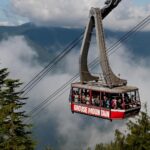British Columbia is a nature lover’s paradise with rugged coastlines, alpine peaks, old growth forests and wild rivers. The province is home to 7 national parks each with its own stunning scenery and unique outdoor experiences. Whether you’re a hiker, camper, wildlife watcher, or just someone who loves scenic drives, BC’s national parks have got you covered.
From the wind swept beaches of the Pacific Rim to the glacier fed lakes of Yoho these parks showcase the best of Canada’s natural heritage. Here’s your guide to getting wild in British Columbia’s national parks.
Must-See National Parks in BC
Yoho National Park is one of BC’s most popular destinations. Located in the Canadian Rockies it’s home to Emerald Lake famous for its turquoise waters and Takakkaw Falls one of Canada’s highest waterfalls. The park is also a great spot to explore the historic Kicking Horse Pass and the ancient Burgess Shale fossil beds.
The Gulf Islands National Park Reserve is a totally different vibe – serene, coastal and full of biodiversity. Located off the southern tip of Vancouver Island it’s made up of over a dozen islands where you can hike, kayak and relax on quiet beaches lined with arbutus trees and sandstone cliffs.
Pacific Rim National Park Reserve on the west coast of Vancouver Island is a haven for surfers, beach lovers, and storm watchers. Long Beach one of its most famous areas stretches for miles along the Pacific and is perfect for long walks or tidepooling at sunset.
Gwaii Haanas National Park Reserve and Haida Heritage Site is wilderness and Indigenous culture. Located in Haida Gwaii this remote destination offers a powerful connection to nature and the Haida Nation with carved totem poles, abandoned village sites and old growth rainforests.
Get Outside
BC’s national parks are designed to be explored in every season and at every pace. If you’re into hiking there are trails from family friendly boardwalks to challenging alpine climbs. Yoho’s Iceline Trail has glacier views and Pacific Rim’s Rainforest Trail has mossy woods. Camping is available in most parks with both backcountry and serviced sites. Whether you’re pitching a tent by a lake or sleeping under the stars in the forest the experience is always memorable. Don’t forget to book ahead especially in summer.
For a different perspective, try boating or kayaking. The sheltered waters around the Gulf Islands and Haida Gwaii are perfect for paddlers. You might even spot whales, sea lions, or porpoises as you explore hidden coves and islets.
Wildlife viewing is a big draw. Depending on the park and the season you might see black bears, bald eagles, elk or even coastal wolves. Bring binoculars and be respectful – these are their homes and we’re just visitors.
Or maybe you just want to slow down. Many parks have picnic spots, peaceful lakes for swimming and scenic views perfect for photography or sketching. Sometimes just sitting quietly in nature is the best adventure of all.
Plan Your Trip to BC’s Parks
Before you go do a little planning. Start by visiting Parks Canada’s website for the most current info on weather conditions, road closures, trail statuses and campsite availability. Each park has its own page with maps, alerts and trip planning tools.
You’ll also want to buy a Parks Canada Discovery Pass if you plan to visit more than one national park. It’s valid for a full year and gives you unlimited access to all national parks, national historic sites and marine conservation areas across the country.
Accommodations range from campgrounds and rustic cabins to nearby lodges and hotels in adjacent towns. Pacific Rim is near Tofino and Ucluelet while Yoho is close to the charming mountain town of Field.
Traveling without a car? Many of the parks especially those on Vancouver Island or near major highways are accessible by public transportation or shuttle services in peak season. Some areas may require a ferry or floatplane ride particularly Haida Gwaii or the outer Gulf Islands – making the journey part of the adventure.
Respect What We Love
When visiting BC’s national parks you’re entering protected wilderness so be responsible. Stay on designated trails, pack out all waste and don’t disturb wildlife. Learn about Leave No Trace principles and teach them to your kids if you’re bringing the family. Even small actions – like picking wildflowers or feeding birds – can harm delicate ecosystems.
Many parks also offer interpretive programs and guided walks where rangers and Indigenous guides share knowledge about the land, its history and how we can help conserve it for future generations.
Support these parks by buying passes, donating to conservation organizations and volunteering where possible to keep BC’s national treasures wild and open to all.
For a Few More Stops
There’s so much more. Canada is filled with amazing places where you will want to return again and again. And it’s impossible to cover all the iconic sites without a proper guide. So, why not explore everything that this great country has to offer with your new travel companion, Canada Hustle?

Available for both Android and iOS users, finding any site within the cities has never been easier. Canada Hustle offers experiences as unique as your travel style—from bold to serene and everything in between.
Final Thoughts: A Journey Worth Taking
From misty coastlines to mountain glaciers, ancient rainforests to sacred cultural sites, British Columbia’s national parks are more than just a place to hike or camp – they’re about connection to nature, heritage and a slower pace of life.
Whether you’re a weekend warrior or planning the trip of a lifetime the national parks of BC invite you to breathe deeply, tread lightly and stay curious.
So lace up your boots, grab your camera and get outside – BC’s best natural wonders are waiting.
Last Updated on August 19, 2025 by Joshita







